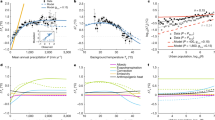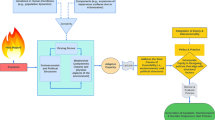Abstract
The growing trends of urbanization and climate change have increased urban heat exposure and challenges in the past few decades. Extreme heat conditions have become more common in the past few years, with climatic changes and extremes becoming more evident in the future. Even if the world can make progress on mitigating climate change by drastically reducing the emission of Greenhouse Gases (GHGs), these trends are projected to continue in the coming decades. This chapter first discusses natural- and human-made drives of extreme urban heat events. We then highlight major urban heat adaptation and mitigation measures and strategies that are explored in this volume. We argue that mitigation measures have received more attention in science and policy circles, and a more balanced approach is needed to strengthen the adaptive capacity of communities. For this purpose, it is essential to adopt systemic approaches that are facilitated by decision-support tools enabled by advances in information and communication technologies and big data analytics. Such systemic approaches would also help promote justice in the context of urban heat adaptation and mitigation.
Access provided by Autonomous University of Puebla. Download chapter PDF
Similar content being viewed by others
Keywords
1 The Urgency of Urban Heat Adaptation and Mitigation and the Contribution of This Volume
Urban heat challenges are products of the combination of extreme heat conditions and the urban heat island effect. Extreme heat conditions have become more common in the past few years, with the climatic changes becoming more evident with every passing year (He et al., 2023). According to the World Meteorological Organization (WMO), the past eight years have been the warmest years on record, with 2016, 2019, and 2020 being the top three (WMO, 2023). Even if the world can make progress on mitigating climate change by drastically reducing the emission of Greenhouse Gases (GHGs), these trends are projected to continue in the coming decades due to the historical emissions (IPCC, 2023). Indeed, the recent synthesis report of the Intergovernmental Panel on Climate Change (IPCC) makes it clear that extreme heat events can occur even at low global warming levels (IPCC, 2023). Needless to mention that under some future climate scenarios, the average temperatures can exceed 5° beyond the pre-industrial levels, with enormous consequences for the ecosystem, economy, infrastructure, and human health and well-being (IPCC, 2023).
In addition to climate change, the urban heat island effect is a key driver of extreme urban heat. It is a condition when temperatures in urban areas are higher than in the surrounding rural areas. Various factors, such as the physical design of cities, the albedo of urban surfaces, the type of materials used, the amount of heat exhaust from automobiles and air conditioners, etc., contribute to the urban heat island effect. Urban heat is not only limited to the Urban Heat Island (UHI). It includes several other factors, like humidity, air pollutants, and combined effects of atmospheric factors.
It is evident that measures aimed at addressing extreme urban heat challenges should address issues related to climate-induced extreme heat events as well as those associated with the urban heat island effect. The key point to keep in mind is, however, that the window of opportunity to take action in urban areas is narrow and will close in the coming decades. Currently, about 56% of the world’s population lives in urban areas, and this share is expected to reach approximately 68% by 2050 and always keep in mind that the surface covered by cities is only 3% (UN, 2018). Most of the future world urban population growth will occur in the developing countries of Africa and Asia. The way these new urban settlements are going to be built will have major implications for addressing urban heat issues. It is essential to consider urban heat mitigation and adaptation strategies throughout different stages of urban planning, design, and management in both new and existing cities. Such strategies can provide multiple co-benefits in terms of reducing health risks and quality of life, ensuring better environmental quality, minimizing infrastructure damage, and reducing socio-economic inequalities (Sharifi, 2022; Sharifi et al., 2021). In addition, given the tight nexus between urban heat and energy consumption, measures aimed at addressing urban heat challenges will also provide co-benefits and synergies for climate change mitigation (i.e., reducing sources and/or enhancing sinks of emissions) (Lwasa et al., 2022; Sharifi, 2021).
This volume advances the knowledge of urban heat mitigation and adaptation strategies by offering new insights into “Concepts, Theories, and Trends” (Part I), “Mitigation and Adaptation Strategies” (Part II), and “Policies” (Part III). Figure 1 shows that various issues and measures related to mitigation and adaptation have been addressed throughout the volume. The dominant measures are related to green infrastructure (e.g., ponds, green walls, roofs, urban greenery, vegetation, etc.), urban planning and design (urbanization patterns, street canyon design, shading environment, courtyards, land use planning, etc.). These are mainly related to mitigating urban heat risk. However, they could also contribute to urban heat adaptation. Regarding the latter, it can be observed that issues related to justice and vulnerable groups are also covered in the volume. However, they have received relatively less attention despite the urgency of taking action to address such inequalities in cities.
2 The Way Forward
A recent study by He et al. (2023) has highlighted the thematic focus of the literature on urban heat adaptation and mitigation. The key thematic focus areas covered by the existing literature are shown in Fig. 2. Comparing Figs. 1 and 2 shows that this volume has covered most of the popular research themes. More specifically, issues related to urbanization and implications for land surface temperature and urban heat island effect, green and blue infrastructure for urban heat adaptation and mitigation, and design measures for improving outdoor thermal comfort are common between the two figures. The two figures also show that issues related to adaptation, health, and vulnerability have received relatively less attention from the scientific community.
Major issues addressed in the literature on urban heat (He et al., 2023)
While understanding the physical and climatological drivers of urban heat and exploring the effectiveness of different mitigation strategies is essential to address the issue, it can be argued that already a good amount of knowledge on these issues exists that can guide action plans. More research, however, is needed to address the implications of urban heat adaptation/mitigation measures for other urban issues such as justice, air quality, and vulnerability. Figure 3 indicates that some of these issues have been addressed in Part III of this volume, which is focused on policies. However, more work is needed to understand better what models should be promoted to develop effective, efficient, and just urban heat adaptation and mitigation strategies. Finally, as also emphasized in He et al. (2023), the existing research landscape is unbalanced, with mitigation receiving more attention. More systemic approaches that allow balanced attention to mitigation and adaptation are, therefore, needed. The advances in modeling and big data analytics offer opportunities to promote more systemic approaches and should be further explored in future studies.
Finally, the framework of climate-resilient development should be considered. It combines strategies to adapt to climate change with actions to reduce greenhouse gas emissions to support sustainable development for everyone. This means reducing exposure and vulnerability to climate hazards, cutting back greenhouse gas emissions and conserving biodiversity are given the highest priorities in everyday decision-making and policies on all aspects of society, including energy, industry, health, water, food, urban development, housing, and transport and is mostly required and demanded in urban areas. It is about successfully navigating the complex interactions between these different systems so that action in one area does not have adverse effects elsewhere and opportunities are harnessed to accelerate progress toward a safer and fairer world (IPCC, 2023).
Climate Resilient Development isn’t achieved with a single decision or action. It is the result of all of the choices we make about climate risk reduction, emissions reduction, and sustainable development on a daily basis. New scientific evidence shows that addressing the risks and impacts of climate change successfully involves a more diverse set of actors than previously thought—it not just policy-makers but everyone in government, civil society, and the private sector (IPCC, 2023). Lastly, we hope this volume is a suitable collection for urban sustainability research, providing new knowledge, capacity, and case study examples for cooling city concepts, strategies, and policies.
References
He, B.-J., Wang, W., Sharifi, A., & Liu, X. (2023). Progress, knowledge gap and future directions of urban heat mitigation and adaptation research through a bibliometric review of history and evolution. Energy and Buildings, 287, 112976.
IPCC. (2023). Synthesis report of the IPCC sixth assessment report (AR6). The Intergovernmental Panel on Climate Change. https://www.ipcc.ch/report/ar6/syr/. Accessed 31 March 2023.
Lwasa, S., Seto, K. C., Bai, X., Blanco, H., Gurney, K. R., Kilkiş, S., Lucon, O., Murakami, J., Pan, J., Sharifi, A., & Yamagata, Y. (2022). Urban systems and other settlements. In: P. R. Shukla, J. Skea, R. Slade, A. Al Khourdajie, R. van Diemen, D. McCollum, M. Pathak, S. Some, P. Vyas, R. Fradera, M. Belkacemi, A. Hasija, G. Lisboa, S. Luz & J. Malley (Eds.), IPCC, 2022: Climate change 2022: Mitigation of climate change. Contribution of working group III to the Sixth assessment report of the intergovernmental panel on climate change. Cambridge University Press. https://doi.org/10.1017/9781009157926.010
Sharifi, A. (2021). Co-benefits and synergies between urban climate change mitigation and adaptation measures: A literature review. Science of the Total Environment, 750, 141642.
Sharifi, A. (2022). Sustainability and resilience co-benefits and trade-offs of urban climate change adaptation and mitigation measures. In M. Lackner, B. Sajjadi, & W.-Y. Chen (Eds.), Handbook of climate change mitigation and adaptation (pp. 1369–1403). Publishing.
Sharifi, A., Pathak, M., Joshi, C., & He, B.-J. (2021). A systematic review of the health co-benefits of urban climate change adaptation. Sustainable Cities and Society, 74, 103190.
UN. (2018). World urbanization prospects: The 2018 revision, online edition. Department of Economic and Social Affairs.
WMO. (2023). Past eight years confirmed to be the eight warmest on record. World Meteorological Organization. Accessed 31 March 2023.
Author information
Authors and Affiliations
Corresponding authors
Editor information
Editors and Affiliations
Rights and permissions
Copyright information
© 2023 The Author(s), under exclusive license to Springer Nature Singapore Pte Ltd.
About this chapter
Cite this chapter
Sharifi, A., Matzarakis, A., He, BJ., Cheshmehzangi, A. (2023). Conclusions and the Way Forward. In: Cheshmehzangi, A., He, BJ., Sharifi, A., Matzarakis, A. (eds) Climate Change and Cooling Cities. Urban Sustainability. Springer, Singapore. https://doi.org/10.1007/978-981-99-3675-5_17
Download citation
DOI: https://doi.org/10.1007/978-981-99-3675-5_17
Published:
Publisher Name: Springer, Singapore
Print ISBN: 978-981-99-3674-8
Online ISBN: 978-981-99-3675-5
eBook Packages: Earth and Environmental ScienceEarth and Environmental Science (R0)







